Continue your photo travel tour of India while Joan Ubide discovers the southern part of the country.
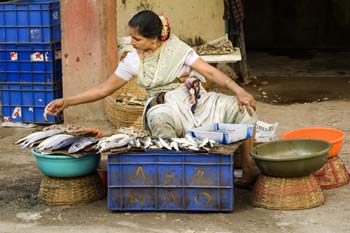
Copyright © Joan Ubide
Fish in Palolem, Goa
1/125 F/5.6, iso 160, 70mm
Previously, I shared my story of my travel into the barren region of North India. In the next step of my journey, I headed toward a different India in the south.
I started in Goa, the smallest region, but also the one most visited by
tourists. It looked to me like the Dominican Republic–palm trees, resorts, beautiful beaches, but it was all too “set up” for tourists to suit my taste. That wasn’t the India I had known in places like Varanasi, Delhi, or any other city in Rajasthan. To me, what I was seeing was not India. However, if you look hard enough for something, you finally find it.
In Goa, I toured most of its beaches and cities, beginning with Anjuna. But I soon grew tired of all those poor people who make a living selling
souvenirs and bracelets. Even when you’re sleeping, they start their
typical barrage of questions:
“Country, Sir?”
“First time in India?”
“What’s your name?”
“Do you want to see my shop?”
Or “Massage?”
Or (my favorite) “Do you want me to clean your ear?”
The ear-cleaning offers sounded very funny to me. From a distance of thirty meters, the service-provider would stare at my ear with a worried face, as if there was something terribly wrong. Then he would say that I had soap in my ear, but he could clean it. Right. No one ever explained how the ear-cleaners could see soap in my ear from thirty meters.
The sales pitches continued perhaps twenty times per day. Grrr! I felt guilty about my resentment, because they’re good people merely trying to make a living from the tourists. However, their persistence is a mistake, because they scare people away.
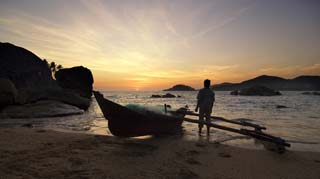
Copyright © Joan Ubide
Sunset, Palolem beach,
1/125 F/5.3 (-0.33), iso 100, 12mm
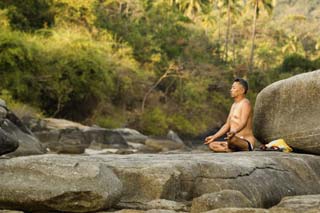
Copyright © Joan Ubide
Meditation, Goa
1/125 F/4, iso 100, 125mm
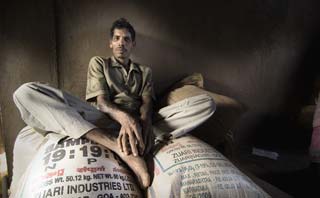
Copyright © Joan Ubide
Man & Rice, Village in Goa
1/20 F/4 (-1), iso 160, 12mm, levels and saturation artwork
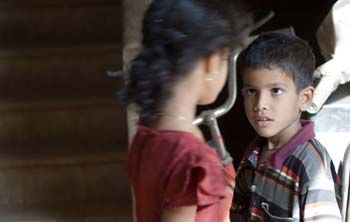
Copyright © Joan Ubide
Deep look, Village in Goa
1/45 F/3.8, iso 160, 105mm
Anyway, if you ever travel to Goa, I recommend the South, especially
Palolem. There you can find the Palolem beach, where there’s less
“harassing” and hundreds of places to sleep and eat. Close by, you’ll find places like Agonda, where you’ll feel much more relaxed.
It’s also worth visiting Panjim, Vasco de Gama, Margao, and Chaudri–cities
that are well connected by bus (although the buses are always crowded). Buses are very cheap means of transport (50 km, 1-2 hours, for 40 rupees–just one US dollar). The driver cries out the destination of the vehicle, but if you’re scared of risky passing maneuvers, you had better choose a taxi, instead. Driving customs in India are very different from ours. Last minute swerving–to avoid a truck, car, motorbike, or cow–is the daily bread. In my opinion, the best way to see the area is by motorbike. I recommend renting one once you’ve decided where to stay. You’ll have to bargain, and it can cost about 150-300 rupees per day ($4 to $8 US).
From Palolem, I took a train to the south, and in two hours I set foot in Gokarna, in the Karnataka region, which is much purer and more genuine than the tourist destinations, as well as being cheaper–like everywhere else in India. Gokarna is a small town with very nice people and an endless, calm beach–a good place if you’re looking for quiet. I recommend the Flower Garden Café, a very, very, very simple place that faces the sea. It’s a charming restaurant for only 150 rupees (less than $5 US).
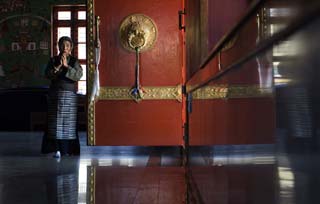
Copyright © Joan Ubide
Temple door in Tibetan camp, Kushalnagar
1/80 F/4.2 iso 200, 50mm
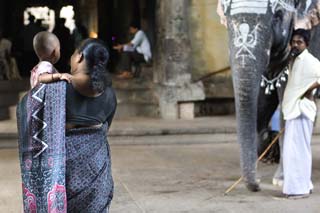
Copyright © Joan Ubide
Elephant in Temple, Madurai
1/30 F/2.7 (-0.33), iso 160, 50mm
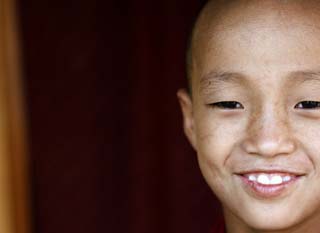
Copyright © Joan Ubide
Tibetan Child in Kushalnagar
1/45 F/3.3 (-0.33), iso 160, 50mm
Karnataka is an interesting region. I explored the coastline by bus. I used to stop when I saw a nice beach, even if it wasn’t close to a village. The people from the bus found this very amusing and looked at me as if I were nuts. In two weeks, I didn’t see a single tourist, but I was welcomed by the locals. When they see you, they inform the rest of the clan, saying “Foreigner, foreigner.” They find your presence funny and ask you where you come from and if it’s the first time you’ve visited India. Most of them are fishermen, and I really enjoyed their company, especially that of their children.
The contrast between the regions of India gave me food for thought. Sadly, India is growing non-stop and is nearly out of control. Even poor families have four or five children, so it won’t take long before India will be the most densely inhabited country on the globe. Meanwhile, the country’s poverty increases—and so does the number of rich people. It’s a country in which the wealthy people outnumber the total population of Spain. Social classes grow further and further apart, as the rich get richer and the poor get poorer. Many people are greatly influenced by Western culture. To me the effect was shocking. I would be watching TV and see American-style rap singers and girls barely dressed, while on the streets most women covered their whole bodies in traditional Indian clothes.
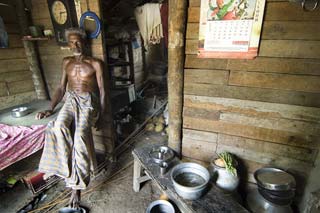
Copyright © Copyright © Joan Ubide
80 years young, Allapuzza,
1/10 F/4 (-0.33) iso 125, 12mm
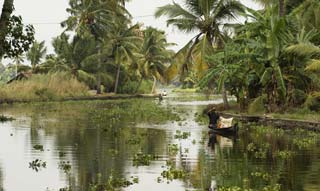
Copyright © Joan Ubide
Backwatters in Allapuzza
1/200 F/7.1, iso 125, 125mm
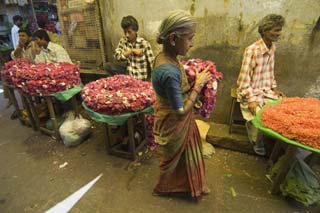
Copyright © Joan Ubide
Flower Market in Mysore,
1/90 F/4.8 (+0.33), iso 125, 12mm
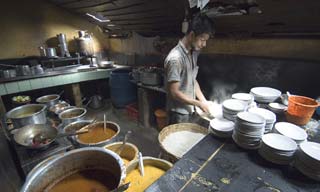
Copyright © Joan Ubide
Local restaurant in Ooty
1/6 F/4 (-0.33), iso 200, 12mm
When I arrived in the south of the Karnataka region, I traveled from Mangalore to the interior of the country–Madikeri and Kushalnagar, where I visited an area hosting exiles from Tibet. From there I headed to Mysore, where I recommend a visit to the market. In the Tamil Nadu region in the far south, I explored Udagamandalam and Coonor, a good area to see national parks and vast tea plantations. Even farther to the south, I visited Coimbatore and, again, the coast, where I reached the Kerala region, specifically Fort Cochi, a very interesting place. Then I headed to Alapuzza, where you can find the famous backwaters–long channels where you can sail in so-called home boats (indulgent but very recommendable). From there I went by boat to the south to reach Kollam, and afterwards by bus to Varkala, a tourist zone where Ayurvedic medicine is practiced.
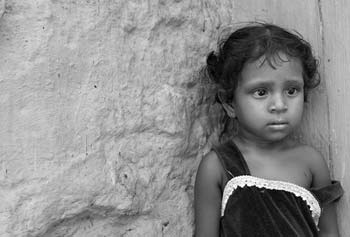
Copyright © Joan Ubide
Girl in Kanyakumari
1/80 F/4.2, iso 125, 22mm
I crossed Kerala and made it to the far end of India, where I visited Kanyakumari, a fishing village that suffered from the Thailand tsunami. From there, I continued to Madurai where I rediscovered “North India.” From Madurai, I took a train to Chennai to go to the Andaman Islands, where I spent two weeks. However, when the Birmanian Typhoon arrived, I removed myself to Calcutta, then used a few days to visit Varanasi, Delhi, and to encounter a new phase of my journey visiting Iran. From there I’ll head to Turkey and on to Amorgos, in Greece. I’m anxious to visit Amorgos, where most of the film The Great Blue (a classic for those who love the sea) was set. It would be a beautiful place to finish my year of travel and photography.
In conclusion, if you want to visit the whole of India, you need a lot of time–years. However, after spending six months there, I can give you some basic advice: If you come to India for a couple of weeks, use taxis. If you’re planning to stay in the country for a couple of months, also use the trains, buses, and planes. But if you have plenty of time, travel light and buy a second-hand Vespa. You can get one for only $100 US, and it’s the best way to enjoy the country. You can even take it on the train for a few rupees. When you finish your visit, you can send the Vespa home for $500 US and resell it for about $1,200—especially now that they’re in demand. And you will have experienced one full year in India–a great year.
by Joan Ubide

Leave a Reply